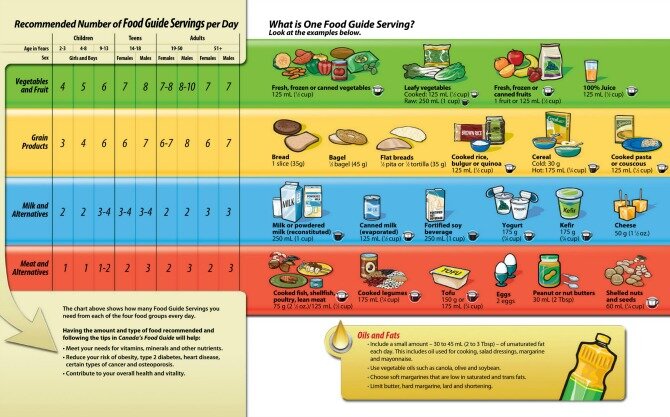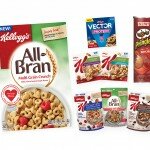
Many of us, myself included, have made a New Year’s resolution to eat healthier and be more physically active. If these are among your goals for 2013, or if you just want to be certain you are making the right food choices for you and your family; be sure to check out Canada’s Food Guide, it is a great tool.
Eating Well with Canada’s Food Guide provides recommendations on how many servings of each food group you should eat each day, including Vegetables and Fruit, Grain Products, Milk and Alternatives, and Meat and Alternatives. The Food Guide also encourages people to limit foods and beverages that are high in calories, fat, sugar or salt (sodium).
By following the recommendations in Canada’s Food Guide, you will get the vitamins, minerals and nutrients you need. You may also reduce your risk of obesity, Type 2 diabetes, heart disease, certain types of cancer and osteoporosis, as well as contribute to your overall health and vitality.
To eat well, start by following these easy tips for the four food groups:
Vegetables and Fruit
- Eat at least one dark green and one orange vegetable each day.
- Choose dark green vegetables such as broccoli, romaine lettuce and spinach.
- Go for orange vegetables such as carrots, sweet potatoes and winter squash.
- Choose vegetables and fruit prepared with little or no added fat, sugar or salt.
- Enjoy vegetables steamed, baked or stir-fried, instead of deep-fried.
- Have vegetables and fruit more often than juice.
Grain Products
- Make at least half of your grain products whole grain.
- Eat a variety of whole grains, such as barley, brown rice, oats, quinoa and wild rice.
- Enjoy whole grain bread, oatmeal and whole wheat pasta.
- Choose grain products that are low in fat, sugar and salt.
- Compare the Nutrition Facts table on labels to make wise choices.
- Enjoy the true taste of grain products. When adding sauces or spreads, use small amounts.
Milk and Alternatives
- Drink 500 ml (2 cups) of skim, 1% or 2% milk every day for adequate vitamin D.
- Drink fortified soy beverages if you do not drink milk.
- Select lower-fat milk alternatives.
- Compare the Nutrition Facts table on yogurt or cheese labels to make wise choices.
Meat and Alternatives
- Eat meat alternatives such as beans, lentils and tofu often.
- Eat at least two Food Guide Servings of fish each week.
- Choose fish such as char, herring, mackerel, salmon, sardines, and trout.
- Select lean meat and alternatives ready with little or no added fat or salt.
- Trim the visible fat from meats. Remove the skin from poultry.
- Use cooking methods such as roasting, baking or poaching that need little or no added fat.
- If you eat luncheon meats, sausages or prepackaged meats, choose those lower in salt (sodium) and fat.
A diet low in saturated fat and trans fat can help reduce the risk of cardiovascular disease. For good health, include a small amount of unsaturated fat each day such as canola, olive or soybean oil, margarine or mayonnaise.
If you’re thirsty, make water your beverage of choice. It’s a great calorie-free way to quench your thirst. Limit your intake of soft drinks, sports drinks, energy drinks, fruit drinks and punches, sweetened hot and cold beverages as well as alcohol. These beverages can be high in calories and low in nutrients.
For more information on healthy eating, please visit:
- Eating Well With Canada’s Food Guide
- Eat Well Central
- Advice for Different Ages and Stages
- Using the Food Guide
- The % Daily Value
- Eat Well and Be Active Educational Toolkit
Information contained in this post was obtained from the Health Canada website.




























Fantastic info for Canadians, thanks so much for sharing! And thanks for joining the Canucks Rock: All Canadian Link Up!
Stacey, it certainly is a great guide to keep in mind when planning meals!
thank you for sharing lovely post
You are very welcome Akheela, I’m glad you enjoyed it.
With all the diet fads out there causing confusion, you know you can always count on the Canadian Food Guide for the true information to aide in a long and healthy life. Great share!
I love the Canada Food Guide! It’s so easy to follow and has everything you need to know for leading a healthy lifestyle. Thanks for sharing!
The food guide is a great reference which we should all be using. Following the food guide is key to a healthy lifestyle.